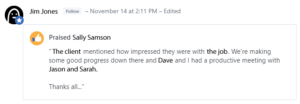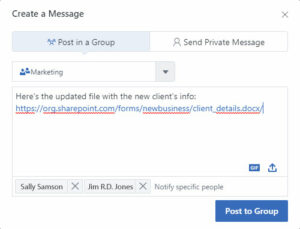Avoiding the “super-hype”
AI will be transformational, so we don’t need to debate or doubt that. However, when we look at the implications for businesses, we need to take a breather and blow a bit of the froth from the super hype around AI that is being whipped up right now. There is both fear and excitement in equal measure, and in many cases, both are unfounded. This is just distracting for businesses as they plan for the future. My contention is that by thinking clearly and taking good advice, businesses can avoid expensive mistakes and find value in practical and relevant applications of AI today.
We hear a lot about the societal and political implications of AI replacing some or even all white-collar work in future. While this makes for interesting and provocative reading, I want to focus on what business leaders should be thinking about today.
We are still in the very early days of this AI wave, and that creates hype. The news sites want content that is sensational, and the consulting firms want you to pay for consulting projects to alleviate the fear they create. You’ll notice that many blogs, articles, and IT talks use words like “could” and “should” rather than “does” and “will.” You also frequently hear “expected,” “projected,” and “forecasted” from consulting firms.
We are in “super-hype” territory, similar where we were with Cloud 15+ years ago. Was cloud transformational? Yes, it was, completely – the world got smaller, markets grew, and all of us got access to the technologies previously reserved for the global giants. We got this for a small fee per user plus a lot more. It took time for that value to filter through though, and for markets and technologies to mature. I expect AI to mature faster, and the potential impact to be broader but for most of us, the same principles will apply over the next couple of years.
We are seeing a lot of hype right now, particularly around ChatGPT and Copilot. Is ChatGPT delivering huge value to the masses really? Is Microsoft Copilot going to give you a real competitive advantage right now? They are very useful tools for sure but not earth-shattering yet. The whole arena is still immature.
Unless you are a very large business, a corporate giant, a specific niche player or perhaps a research organisation, I’d say your requirements will be met naturally by the market. It’s happening now, and you will not miss the boat if you think this through carefully and take advice from trusted and qualified technology partners.
Value from AI today
Although in their early stages, there is value to be had today from practical applications of AI, largely at the Machine Learning end of the spectrum. Many software and platform vendors are building and buying AI technologies to enhance their offerings already, and some have done so for several years. We are seeing steady developments in most business systems, and here are a few examples:
- Cybersecurity: With cyber threats becoming more sophisticated, mid-sized businesses are adopting AI-powered cybersecurity solutions like SentinelOne and MS Defender, which use machine learning to detect and respond to security threats more efficiently than traditional antivirus products. AI can also help businesses with data protection, compliance, and incident response.
- Customer Relationship Management (CRM): Businesses are using AI-enhanced CRM platforms like Salesforce or HubSpot to streamline their sales processes and improve their customer service. These platforms can leverage AI to predict customer behaviour, personalise communication, and automate responses, leading to more efficient sales cycles and higher customer satisfaction.
- Accounting: AI tools are being used to automate bookkeeping and financial analysis. For instance, many accounting platforms use AI to categorise expenses and make tax recommendations. AI can also help businesses with cash flow forecasting, fraud detection, and risk assessments.
- Human Resources and Recruitment: HR tools with AI-enhancement assist in automating payroll, benefits administration, and recruitment processes. AI algorithms can screen resumes, schedule interviews and even predict candidate fit and thereby make hiring process faster and more effective. AI can also help businesses with employee engagement, retention, and development to foster a positive and productive working culture.
- Inventory Management and Supply Chain Optimisation: Mid-sized retail and manufacturing businesses utilise AI for inventory forecasting and supply chain optimisation. Tools like NetSuite or SAP Business One employ AI to analyse sales data and predict inventory needs to reduce overstock and stockouts. AI can also help with demand planning, logistics, and quality control, improving operational efficiency and client satisfaction.
- Marketing and Customer Insights: AI within products, such as Marketo and Pardot help businesses analyse customer data, predict market trends, personalise marketing campaigns and ultimately increase engagement and conversion. AI can also help businesses to create content, manage social media and web analytics to enhance brand awareness and reputation.
- Predictive Maintenance in Manufacturing: Companies are implementing AI for predictive maintenance in manufacturing; using sensors and data analytics to monitor the condition and performance of machines and equipment, predicting and even preventing failures. Tools like IBM Maximo or Microsoft Azure IoT use AI to optimise maintenance schedules, reduce downtime, and extend equipment life, thereby saving costs and improving quality.
Get the right guidance
I hope I have shown that AI is delivering practical and relevant value now for organisations that know how to make use of it. The market is delivering the functionality and evolving it continually. That does, of course, mean that businesses should keep their eyes open and watch their markets.
AI will arrive through the sales engines of technology vendors. And this is where most care is needed: to avoid being swept up by the hype of a new technology, buying vapourware and undertaking projects that will never realise the sold visions and dreams.
Most importantly, this all means that every business needs access to sound advice from partners who live these technologies daily and whom they can trust to provide practical guidance rather than speculation. I always recommend appropriate research, evaluation and piloting to build awareness and familiarity. There is value to be had for sure, but we do need to calm some of the hysteria.
Microsoft’s premier annual event, Microsoft Inspire 2023, recently concluded, providing industry leaders and partners alike with a glimpse of Microsoft’s vision for the future. There’s no doubt that Microsoft wants to empower individuals worldwide to work in a new AI-driven way, expanding the scope of AI technology to help everyone in various aspects of their roles. In this recap blog, we’ll highlight some of the key takeaways from the event and how it sets the stage for a secure and AI-driven business landscape.
Advancing AI ambitions
Regardless of your feelings about AI technology, it’s hard to ignore the platform change that Satya Nadella (Chairman and CEO at Microsoft) laid out in the keynote speech. The next big shift in our way of working is here – using natural language as our interface with technology, facilitated by AI.
The event marked the launch of two groundbreaking AI-driven solutions, Bing Chat Enterprise and Microsoft 365 Copilot, promising to redefine how we work, delivering increased efficiency for business advantage through AI-driven insights and automation.
During the event, Microsoft detailed the functionalities and pricing of these new tools:
- Bing Chat Enterprise: Think of it as Google on steroids, working with both public and private data while maintaining appropriate data governance to ensure your IP is not leaked. Currently available in preview, we expect this to roll out in late 2023 or early 2024 for Microsoft 365 E3, E5, Business Standard, and Business Premium users at no additional cost. For those rare clients without some form of M365 licensing, the standalone offering will be available for $5 per user per month.
- Microsoft 365 Copilot: While Bing Chat Enterprise will reference business data and aid you in your day-to-day tasks, Copilot takes it to the next stage of evolution It offers integrated AI that can work with and for you in your native applications, through a natural language interface. Hand off those menial tasks and focus on the exciting stuff. Microsoft has initially released Sales Copilot, with the promise of wider integration to come and we finally know how much it will cost. $30 per user per month for Microsoft 365 E3, E5, Business Standard, and Business Premium clients. While it may feel expensive for some, how and who you deploy it for will be key.
- New AI capabilities across Microsoft 365: AI is coming to the rest of the M365 suite, enhancing productivity and engagement with features like Copilot in Teams Phone and Chat, Microsoft Viva updates, Windows 365 Frontline, Microsoft 365 Backup, and Microsoft 365 Archive.
To learn more, read the blog post by Colette Stallbaumer, General Manager, Microsoft 365 and Future of Work here.
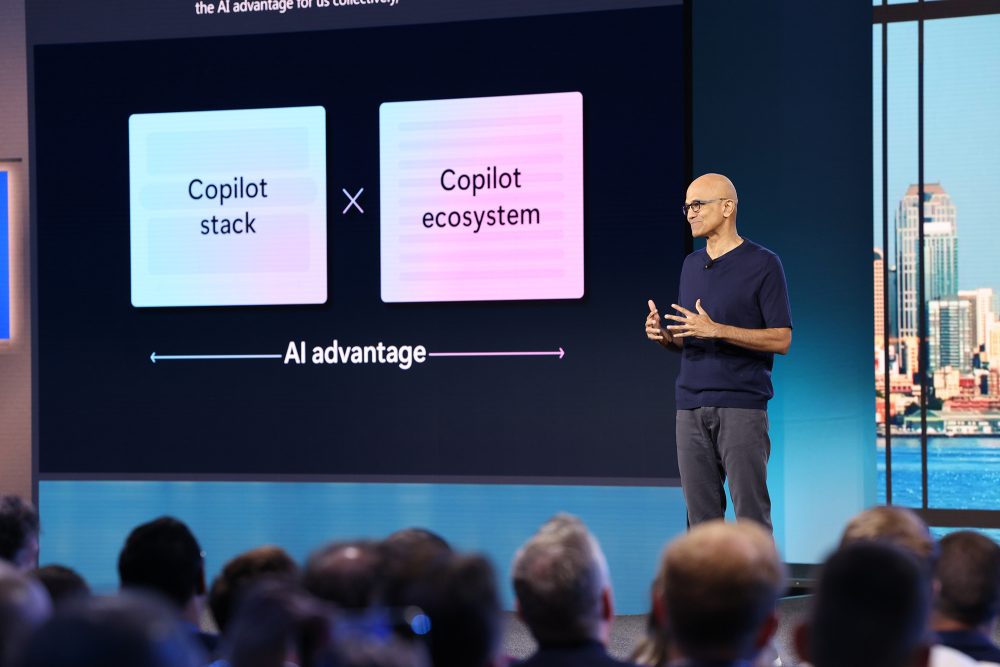
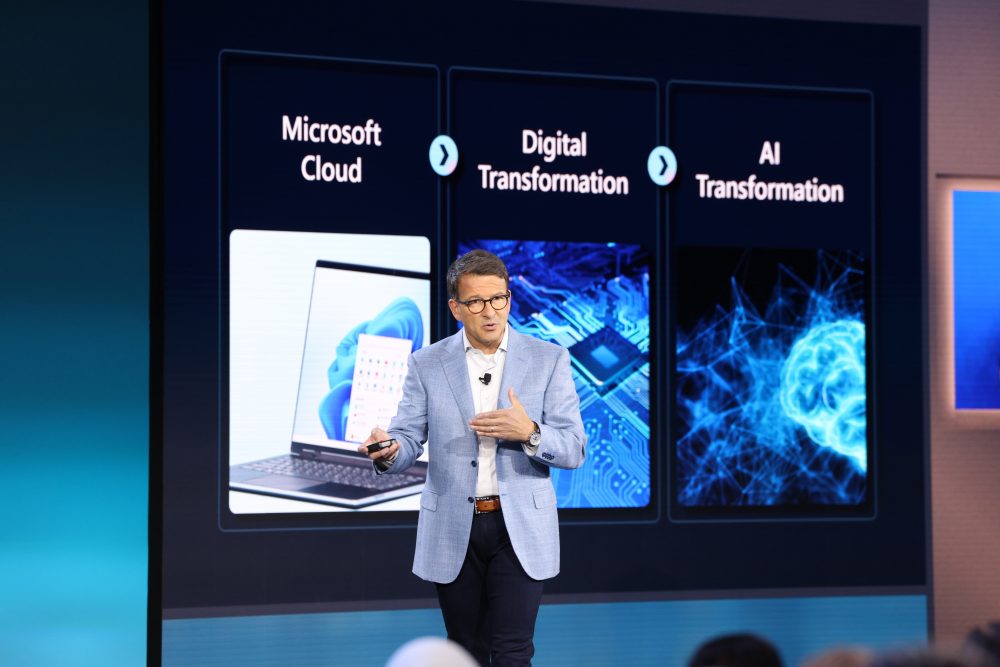
Embracing the future of security with AI
Emerging technologies are rapidly evolving, and cybersecurity has become more crucial than ever before. Microsoft Inspire cast a spotlight on the future of security powered by AI, highlighting the unique opportunity to harness AI’s power alongside an end-to-end security solution for building a resilient security posture with rapidly adaptable defences.
Based on Microsoft’s internal data, cyber-attacks are rapidly adopting automation through AI-assisted tools. The number of password attacks detected by Microsoft has surged significantly, growing over threefold in the past year, from 1,287 per second to more than 4,000 per second. As a result, the cost of cyberattacks is continuously rising. If organisations stick to outdated security measures and only rely on past strategies, they may leave vulnerabilities in their security posture.
Partners and clients were introduced to valuable resources to strengthen their defences against ever-changing threats. They showed how using AI can help to spot and stop potential risks before they become a problem. They also emphasised the importance of safeguarding critical data and customer information. Throughout the event, it was clear that Microsoft is dedicated to empowering businesses with smart security solutions.
For the full details, read the announcement here to learn more.

Conclusion
Microsoft Inspire 2023 revealed a series of key announcements and technologies, showcasing the tech giant’s dedication to AI advancements and comprehensive security solutions. From fortified cybersecurity measures to innovative AI tools elevating collaboration and productivity, Microsoft is continuously pushing the boundaries in the tech space.
As the digital landscape continues to evolve, embracing these transformative technologies becomes crucial for achieving business success in today’s competitive environment. Sure, these technologies can be exciting, but we get it – they can also feel overwhelming, and you don’t have to navigate it alone.

We are proud to announce our achievement of the Microsoft Solutions Partner for Infrastructure (Azure) designation. This recognition represents a significant milestone in QuoStar’s journey to provide unparalleled cloud solutions and support to our valued clients. In this blog, we will delve into what it means for both QuoStar and our clients to be a Microsoft Solutions Partner for Infrastructure (Azure), highlighting the benefits and expertise we bring to accelerate their digital transformation.
In 2022, Microsoft introduced a transformative evolution of their partner program, replacing the traditional Gold and Silver competencies with Solution Partner Designations. By achieving the Solutions Partner for Infrastructure (Azure) status, QuoStar demonstrates our unwavering commitment to staying at the forefront of industry advancements and equipping our clients with cutting-edge solutions.
Let’s explore how our expertise translates into tangible benefits for our clients:
As a Solutions Partner for Infrastructure (Azure), QuoStar possesses a diverse range of capabilities aimed at empowering our clients to expedite the migration of their critical infrastructure workloads to Microsoft Azure when best placed to do so.
- Comprehensive Infrastructure Services: With our broad capabilities, QuoStar excels in designing, implementing, operating, and optimising infrastructure architectures that drive efficiency, cost-effectiveness, and robust security measures. We collaborate closely with clients to ensure their infrastructure aligns with their unique business requirements and objectives.
- Seamless Workload Migration and Modernisation: QuoStar is well-versed in the art of migrating and modernising diverse workloads, including virtualised environments and virtual desktops. We leverage our in-depth understanding of Azure to deliver seamless and efficient transitions, enabling clients to unlock the full potential of the cloud.
- High-Performance Computing and Azure Management: Our expertise extends to the onboarding and management of high-performance computing workloads in Azure. We empower clients to harness the capabilities of Azure for resource-intensive tasks, unleashing new levels of productivity and performance. Additionally, our adeptness in management, governance, security, and DevOps with Azure Arc ensures clients have robust control over their on-premises, cloud, and multi-cloud environments.
- Driving Customer Trust and Recognition: The Solutions Partner for Infrastructure (Azure) designation acts as a mark of distinction, allowing clients to identify QuoStar as a trusted partner with a proven track record of success. Our commitment to training, accreditation, and delivering exceptional solutions guarantees clients that their infrastructure will be in expert hands.
- Certified Professionals: Our team includes certified professionals who have achieved Microsoft 365 Certified: Enterprise Administrator Expert certification as well as becoming Microsoft Certified: Azure Developer Associate. These certifications showcase our team’s deep understanding and expertise in Microsoft technologies. By continuously investing in our employees’ professional growth, we ensure that they stay up-to-date with the latest industry trends and best practices.
“With Azure’s powerful capabilities combined with our multi-cloud approach QuoStar can provide enhanced scalability, security, and reliability to meet the evolving needs of our clients. The designation not only strengthens our reputation but also positions us as a trusted partner in the Microsoft space.”
– Neil Clark, Cloud Services Director at QuoStar
The COVID-19 has had a huge impact on the way businesses deliver IT services to end-users. The lockdown and subsequent restrictions left businesses scrambling to deal with an unprecedented situation where their entire workforce needed to work from home. Most simply weren’t set up for permanent, widescale remote working but had no option but to embrace it to remain operational.
Technology like online meeting and collaboration tools, hosted telephony, VPNs and virtual desktop infrastructure (VDI) saw a surge in adoption as businesses looked for ways to keep their employees connected, productive and secure. Of course, VDI solutions are nothing new. Businesses have been using it for over a decade to deliver desktops and applications to end-users. However, it is seeing a resurgence, both due to current challenges arising from COVID-19 and the maturation of Windows Virtual Desktop. This was highlighted in the recent Spiceworks Ziff Davies 2021 State of IT Report which found 46% of businesses were using or planning to use VDI by mid-2022. Furthermore, 26% of businesses planned to increase VDI deployment specifically because of the new challenges that have surfaced due to the pandemic.
How can VDI solutions help internal IT Teams?
1. Reduced Costs
Delivering desktops through VDI helps reduce the time it takes to provision new desktops. Easy and quick to set up, VDI not only reduces the time required by the IT team and the support costs, but it also provides more immediate value to the business.
VDI can also help IT Managers optimise and reduce their IT spend. Purchasing and upgrading hardware for remote employees is a significant cost, but as a virtual desktop can be accessed from almost any device it can really help slash spend in this area.
2. Simplified Licencing
Software licencing is one of the most common issues for IT managers with remote employees. If an end-user uses a personal device for remote working and needs a particular app to do their job, it’s ITs responsibility to licence this. Not only do multiple licences increase IT costs, but it also complicates licence tracking and compliance. The IT team needs to be able to prove that apps on personal devices are properly licenced and differentiate between corporate-owned software and personally owned software. VDI solutions eliminate this challenge for IT teams by keeping the licenced software within the business’s own data centre and removes the need to track remotely installed apps.
3. Improved Security
Security is a constant concern, even more so with the new threats emerging as a result of the pandemic. It’s a particular issue for IT teams where end users are using personal devices to access company data or systems. There are no guarantees that the device adheres to the company security policy, it may be infected, compromised or running an outdated operating system. However, with VDI, device-level security becomes less important as the user remotely connects a corporate desktop which IT configures to exact security requirements. The personal PC essentially becomes a thin client as all activity takes place in the data centre, with all of the corporate security systems and controls in place.
IS CONFIDENTIAL DATA LEAKING OUT OF YOUR BUSINESS? FIND OUT TODAY WITH A COMPLIMENTARY DARK WEB SCAN
4. Reduced Technical Support Time
IT Managers’ workloads are higher than ever now they need to manage a fully remote workforce on top of their existing responsibilities. VDI solutions make it easier for IT teams to support remote end-users because it puts them in a standardised environment, with the device itself less significant. It also reduces major technical issues and speeds up resolution time because IT teams already have all the information about the user’s virtual desktop systems to hand. Of course, technical issues can still occur with virtual desktop users, but these are usually related to connectivity and performance and are simpler to identify and resolve.
5. Centralised Management
With everything centrally stored, managed and secured, desktop virtualisation streamlines the management of software assets. This makes it easier for the IT team to set up and provide end-users with desktops and applications, no matter where they are located. Administrators can also deploy, patch, upgrade and troubleshoot from a central, singular location, rather than updating end-users’ environments individually.
Are VDI solutions the right choice for every business?
Desktop virtualisation has continually developed over the last decade, but today the main two categories are VDI and DaaS (Desktop as a Service). VDI is suited to businesses who want to host and manage the virtual desktops themselves, on their own servers. DaaS is very similar but removes the need for infrastructure management by delivering it as a cloud service.
Both VDI and DaaS are well placed to deal with the most common challenges of traditional desktop and laptop systems, such as software licencing inventory, ensuring compliance and expensive procurement. Outside of these legacy challenges, both solutions also help businesses deal with IT process concerns, such as keeping up with the rapid pace of change and the time IT staff have to dedicate to routine tasks (e.g. troubleshooting, helpdesk requests).
DaaS has a slight potential edge on VDI due to the shared responsibility of a cloud model. It largely removes the need to manage the physical infrastructure, enabling IT teams to focus on the entire digital workspace and user experience.
The prominent solution that overlaps both categories is Windows Virtual Desktop (WVD). Previous virtualisation options gave businesses limited options over the type of virtual machines they could use to deliver desktops. They had to either compromise on user experience and deploy Windows Server Desktop experiences to achieve the cost benefits of a multi-session. Or, they had to sacrifice on cost and deploy single sessions in Windows 10.
This dilemma, plus the opportunities presented by Azure as a platform, ultimately led to the development of Windows Virtual Desktop (WDS). It’s the only virtual desktop infrastructure that offers simplified management, multi-session Windows 10, optimisations for Office 365 Pro Plus and support for RDS environments. An additional plus, just for IT teams, is the relatively short time to go live. A 100 person business with 4-5 servers could be looking at less than a week to set up from scratch.
Are there any issues with VDI solutions?
However, like any technology option, VDI is not a one–size–fits–all solution. Businesses still need to fully evaluate its suitability for their employees and their ways of operating. For example, while VDI is a good option for remote workers and contractors who need to securely access Office applications, it’s not the best for employees who travel frequently due to latency and VPN issues.
Certain applications also still don’t perform as well in VDI style solutions. Microsoft Teams and Zoom are two of the most widely used conferencing platforms, yet they both have performance issues and limitations in VDI environments. For example, with Microsoft Teams some advanced features may not be available in a virtualised environment, and video resolution can differ. Call and meeting functionality is also only supported on a limited number of platforms. As there are multiple market providers, it’s recommended that you seek consultancy advice or speak to your virtualisation solution provider to confirm you meet the minimum requirements.
VDI is just one element of the technology stack. Don’t forget you’ll need other complementary technologies to address gaps and round out the experience for the end-user if you’re looking to build a fully functioning digital workplace.
With the UK government continuing their phased return to normality, many businesses are now planning how they will manage the return to work process for their employees. Thousands of office workers, such as those in financial services, recruitment and law, have been working remotely since the lockdown announcement on Monday 23rd March. Now, these restrictions are beginning to ease; employers will need to carefully review their workplace to determine how and when it is safe for employees to return.
Managing the return to work may cause significant difficulties for employers as they look to maintain the delicate balance of risk. Will hot desking make social distancing easier or further the spread of the virus? Shift patterns are necessary to service clients, but will this result in employee bottlenecks at entry and exit points? How will we maintain operations and ensure employees feel safe in the work environment?
There are many things to consider and changes to be made, but technology can help to reduce the burden on managers.
What does the return to work guidance say?
The guidance sets out practical steps for businesses focused on five key points, which they should implement as soon as practically possible.
1. Work from home, if you can
Employers should take all reasonable steps to allow employees to work effectively from home. However, if they cannot do this and the workplace is not an establishment that the government have said must remain closed, then employees can return to work if it is safe to do so.
2. Carry out a COVID-19 risk assessment
Employers have a legal duty to protect workers and others from risks to their health and safety. They should carry out a COVID-19 risk assessment in consultation with their employees or trade union to determine which guidelines to put in place. Where possible, businesses with more than 50 employees should publish their risk assessment online.
3. Maintain 2 metres social distancing where possible
Employers should redesign workspaces to maintain 2 metres distance between employees. Measures may include things like moving desks, staggering start times, creating one-way walkthroughs, opening more entrances or exits, or restricting the number of people allowing in meeting or break rooms.
4. Where social distancing cannot be maintained, reduce transmission risk
Employers should look at putting barriers in shared spaces, creating shift patterns or fixed teams to minimise the number of people in contact with one another or ensure colleagues are facing away from each other.
6. Reinforce cleaning processes
Workplaces should be cleaned more frequently, with attention paid to high-use objects like keyboards and door handles. Hand sanitiser or handwashing facilities should be provided at entry and exit points.
The role of technology
There are already reports of employers rushing out to buy the latest tech in a bid to make their offices safer. Some businesses are utilising existing building technology to track the numbers of employees in the office at any one time. In contrast, others are considering surveillance options like thermal sensors, motion detectors, and contact tracing to track the movements of infected employees.
Some of this technology requires significant investment and may be out of the reach of mid-market and growing businesses, particularly during a pandemic when they need to scrutinise every financial decision carefully. There’s also a question of how surveillance will make employees feel, even if the technology is for their benefit. In a time where tensions are already running high, and employees may be reluctant to return to the office environment, the last thing your business wants to do is add to the stress.
However, there are options in technology you’re already using, such as Microsoft 365, which leadership teams can repurpose to help manage the return to work and meet government guidelines with little to no extra cost.
Shifts in Microsoft Teams
Shifts is a schedule management tool that helps you create, updates, and manage schedules for your team within Microsoft Teams.
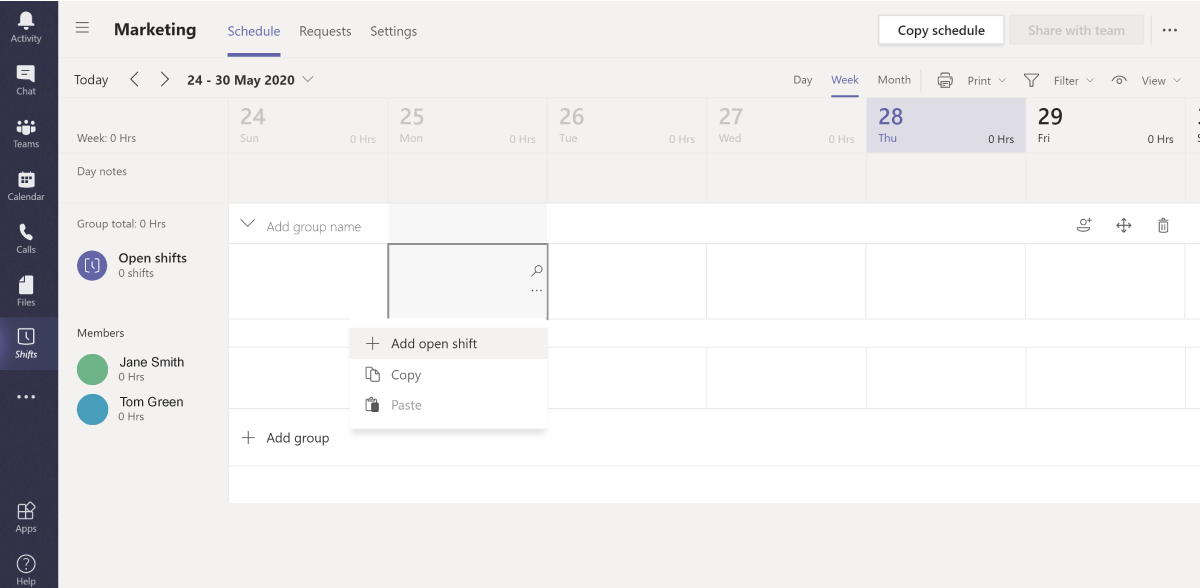
Features in Shifts
- Schedules: Team Owners can create a schedule from scratch or import an existing one from Excel. It shows days at the top and team members on the left-hand side. If you are an owner of multiple teams, you can toggle between different shifts to manage them.
- Day Notes: Add notes to share relevant news or reminders with your team.
- Groups: Name groups by job function or location to keep organised.
- Shifts: Choose a slot to assign a shift, then add activities or specific tasks, so individuals know what they need to complete.
- Requests: Review requests for time off, shift swaps, or offers.
- Time Clocks: Allows employees to clock in or out using a mobile device. Enable location detection to ensure team members clock in from a designated work site.
- Share: Once you’ve finished making edits, share your schedule updates with your team.
Office or Facilities Managers can use Shifts to centrally manage and share available space to employees based on location or floor. Managers can allocate workspace, or allow employees to reserve or request it, ensuring social distancing is maintained wherever possible.
Available as a mobile, web or desktop app, Shifts is included with every Teams licence at no additional cost and your IT administrator can quickly roll it out to your whole business.
App Templates
App Templates are production-ready applications for Microsoft Teams that can help streamline and improve the employee experience. No coding is required, and all templates come with detailed documentation and support guides to ensure smooth deployment and configuration.
- Company Communicator Bot – This app allows businesses to create and send messages to teams or large groups of employees right where they communicate. Companies can use it to share things like new policies, company-wide initiatives, employee onboarding or company-wide broadcasts.
- Incident Reporter Bot – A Microsoft Teams bot designed to streamline incident management in your business. The bot facilitates automated data collection, customised incident reports, relevant stakeholder notifications and end-to-end incident tracking. The bot allows users to report incidents with facilities quickly while providing a centralised location for responders to see and respond to incoming events.
- Scrum Status Bot – A simple scrum assistant bot that enables users to run asynchronous stand-up meetings and provides an easy way for users to share their daily updates. Designed to work in Teams Group chats, all members of that group can contribute to the scrum which could help remote project teams keep their projects up to date and on track.
- Icebreaker Bot – A Microsoft Teams bot designed to help your team become closer by pairing two random co-workers each week to meet. The bot not only helps facilitate conversation and connection between remote teams but could also be helpful if you need to onboard new team members before everyone returns to the office.
- Facilities Bot – Use this bot to send targeted, location-specific updates to employees on Teams, helping manage the use of large communal areas such as cafeterias, kitchens and break rooms.
The office of the future?
The lockdown has shown many businesses that their employees can remain productive and operations can continue outside of the confines of a traditional office. Looking to the future, some may evaluate the cost of ample office space, and if it’s an overhead they really need – or want to – continue budgeting for.
In-person meetings are certainly still valuable, but is there a need for every employee to be in the office for the same set hours each day? Technology has made it vastly easier for teams to remain in contact, and it means your business is no longer geographically confined when it comes to hiring talent.
While there’s no one size fits all policy, this could certainly be an excellent time to review your operations and ways of working to see if changes could make a measurable difference to your business.
Our Client Infrastructure Manager and Azure specialist reviews Microsoft’s Windows Virtual Desktop.
Windows Virtual Desktop (WVD) is Microsoft’s newest Platform as a Service offering. It supports multi-session Windows 10 virtual machines and boasts significant improvements to the user experience and capabilities of certain Office 365 apps in a virtual desktop environment.
WVD became globally available as of September 30th, 2019 and is exclusively delivered on Azure. There’s a lot of good press around WVD, but it’s questionable how much of that is just buzz and how much is solid analysis. This article provides a more nuanced breakdown of how applicable WVD is in a business IT environment, what benefits it brings over other virtual desktop solutions, and whether Azure exclusivity is an issue?
How does Windows Virtual Desktop meet key business requirements?
Cost per user
Unlike VMWare and Citrix virtual desktop solutions, WVD does not require additional per-user licensing (such as RDS CALS or Windows Server) to run, making it very appealing to the price-conscious. This is also particularly beneficial for very large organisations as it limits ballooning costs for big user-bases.
WVD is not completely free though. Each user requires a Microsoft 365 or Windows 10 E3 license and you need to pay for the compute to run the virtual machines within Azure, but’s that’s to be expected.
What is the cost of Windows Virtual Desktop?
The precise cost will vary based on your number of users, the quality of the virtual machines and whether you’re using multi or single sessions, but you’ll be looking at around £8.25 per user per month in compute costs in an optimised environment.
Latency
WVD being restricted to Azure makes latency a hot issue since hosting the virtual machines on in-house infrastructure simply isn’t an option.
The (un)fortunate truth here though is that any latency problems are likely to come from your end, rather than from Microsoft’s. Azure is a global platform and Microsoft has enough money to pour into infrastructure that any latency issues are likely to come from your end rather than theirs.
Whilst this doesn’t solve the problem of latency, it does mean that if you already have the Internet connectivity to support cloud-based virtual desktops on a public cloud platform, Azure will not be a bottleneck.
What will my latency be with Windows Virtual Desktop?
There are a few tools to estimate your latency with Azure. This tool calculates the round-trip time with all eligible WVD regions and this tool lets you compare regions more easily.
In WVD’s documentation, Microsoft recommends a latency of below 150ms for a smooth experience, but VMWare documentation suggests below 250ms is still acceptable for running virtual desktops. Depending on your users and the work being done, you’ll likely have an acceptable experience if you can hit below either of those values.
Scalability
Since WVD runs on Azure, scalability is almost limitless – regardless of the size of the business. The only restriction you may face is how much compute you can afford.
However, since a per-user license isn’t required, the price curve of WVD is much shallower compared to Citrix or VMWare. This frees up budget which can then be funnelled into even more Azure capacity or used to create value elsewhere in your business. So, chances are, WVD will meet your scalability requirements easily.
Interoperability
WVD holds native support for Windows, MacOS, iOS, Android and HTML5 environments – the latter allowing for access through a browser window. This lets a WVD virtual machine run on any mainstream device and opens a host of remote working opportunities.
Being a Microsoft product, WVD also integrates tightly with the other Microsoft products which make up the backbone of your operations such as Office 365, Outlook or Windows Server. This shouldn’t come as a surprise, but the tidiness gives WVD a notable sense of refinement compared to the layers of integration and configuration needed for VMWare or Citrix.
A final point regarding application performance and interoperability is that Microsoft acquired FSLogix during WVD’s development which enables seamless use of stateful applications such as Outlook, Teams and OneNote in a virtual environment.
A practical example of this new functionality is that it now only takes a second or two for a user’s Outlook inbox to populate instead of the minute it would usually take on a virtualised system.
This is achieved by containerising users’ profile data (e.g. emails, notebooks or chat messages) into a separate virtual disk which attaches to the session when needed. When you consider the number of times employees check their emails, this already presents considerable time savings.
Benefits of Windows Virtual Desktop
Free extended security updates for Windows 7 virtual environments
In a move that recognises some companies need to stick with Windows 7 to support specialist software (and perhaps as an enticement to coax Windows 7 users to Windows 10 in the long run), Microsoft will provide free extended security updates through to January 2023 if those Windows 7 desktops are virtualised in WVD.
For companies who haven’t yet migrated from Windows 7, or can’t, this is a lucrative offer since it eliminates the costly security updates (£25 per machine in the first year, £50 per machine in the second and £100 per machine in the third) whilst offering a potentially improved desktop environment with the same updates for free.
Offered as a fully managed Azure service
Managing a virtualised environment has traditionally been an enormous headache for IT teams. Not to mention the upfront slog there is to even get the environment set up correctly in the first place. Microsoft has eliminated much of this pain in WVD by making it a fully managed Azure service.
This takes all the infrastructure management, optimisation and fine-tuning off your plate and tasks like load balancing, diagnostics, gateways and connection brokering are fully managed whilst still being configurable to your requirements.
Configurability also extends to other areas of the virtual environment such as the size of the virtual machines, specific resource allocation to specific user groups, whether users are assigned using a breadth or depth technique and more. These options are managed through the Azure interface rather than requiring configuration on the back-end which keeps things simple for you as well.
In-built security and compliance
Whilst users may think access to files from anywhere on any device is a flexible working dream, for IT teams it sounds a lot more like a security nightmare. Fortunately, Microsoft has provided several security options which can let you sleep easier at night.
Probably the biggest security concern is that data stored on too many devices means an instant GDPR breach if any of those devices are lost or compromised. To alleviate this concern, configurable information protection controls are easily accessible and allow IT Managers to ensure data stays on the virtual machine and never resides on the connecting device.
WVD running on Azure also means you get to have your data and systems hosted in some of the most secure data centres in the world. Security is provided at all layers from software and hardware through to physical defences – which can take another weight off your mind.
Windows Virtual Desktop is Azure exclusive – is this a problem?
Microsoft obviously hopes to increase their cloud market share by making WVD exclusive to Azure, but this decision risks deterring some businesses.
Chances are, if you’re already dedicated to a non-Microsoft cloud (Amazon, Google, IBM) for compliance reasons or because you have a strategy built around it, you won’t be willing to pick up Azure just for the sake of virtual desktops.
Since those are solid justifications, we’re not going to try to convince you to change your path. However, if you’re on the fence regarding Azure or cloud in general, here are some reasons WVD being exclusive isn’t as much of a problem as it seems.
Price
A specific objection to Azure compared to other big cloud providers is that Azure’s pricing has traditionally been prohibitive to smaller businesses without cash reserves. Azure’s pricing previously required upfront payment for the one-year or three-year reserved plans – forcing smaller businesses into the overall more expensive pay-as-you-go plan.
But Microsoft changed this in September 2019 to allow for reservations to be paid with monthly instalments rather than a single fee. For businesses without big cash reserves, this lets them set out a budget whilst also getting access to the savings a reservation provides (which can be as much as 46% for one-year reservations or 72% for three-year reservations).

Data out of your hands
The idea of your most valuable assets and corporate secrets being held in a third party’s hands is honestly frightening for a business. However, in the case of Azure, it’s mostly an unfounded fear.
Your data is likely to be safer in Azure’s data centres than your own due to how Microsoft rigorously adheres to global security standards including ISO 27001 and constantly pours an enormous amount of money into data security.
Whilst you do still need to deploy the solution in Azure correctly for true security (e.g. multi-factor authentication and proper user permissions configuration), these are the sort of things a competent Azure specialist will have in place from day one anyway.
The truth is that this problem comes down to psychology and fear of loss of control. If you’re adhering to best practices during deployment, Azure’s security is more than enough to protect your critical assets.
Azure datacentre downtime
Another common concern with running virtual desktops in the cloud is that if the platform goes down, employees won’t be able to do any work. Azure’s downtime tracker showing a list of several recent downtime events doesn’t help alleviate fears either.
However, you should bear in mind that Azure has at least three million servers. And when operating at that scale, even with 99.99% uptime, there would be 300 servers constantly in a down state. Since there aren’t 300 servers constantly in a down state, Microsoft is doing a pretty good job of service availability.
The concern of downtime is certainly genuine, but to address it you should acknowledge that Microsoft and their army of engineers are probably more capable of managing the hardware side of a data centre with less downtime and shorter downtime windows than you can.
Having the hardware managed by Azure also takes a load off your shoulders and allows you to focus efforts towards activities which are of actual benefit rather than day-to-day maintenance.
Should you get Windows Virtual Desktop for your business?
As of now, the short answer is no. You might be surprised by that answer, but things are much more nuanced if you dig deeper.
If you’re already operating a virtual desktop environment or are an expert in Azure and VDI then yes, WVD is certainly worth reviewing. However, if you plan on using WVD as your first foray into using virtual desktops, it would be best to let it undergo a few months of fixes first.
WVD is on the bleeding edge of virtual desktop solutions right now. Whilst it shows a lot of promise and represents a lot of improvements, it needs refining before it can be considered a best-in-class solution.
Microsoft’s development cycle means it shouldn’t take too long to work out the bugs. And during that time WVD will likely gain some new and improved features – so you’ll even get some additional value for waiting.
In the meantime, upskilling your existing IT team in Azure will provide you with some decent in-house expertise. Additionally, moving to Office 365 now, if you haven’t already, gives your users plenty of time to grow accustomed to the extra features and productivity tools which are included.
What is Sway?
Sway is a presentation tool included within Office 365 which fulfills the role of a “digital storytelling application”. Sway is ideal for creating business reports, presentations or updates. Allowing users to make visually compelling, content-rich presentations without needing any serious design skills.
Sway and PowerPoint are often compared with one another. But whilst they’re both presentation tools, they both fill very different niches. PowerPoint is the ideal tool for presenting content to an audience. Whereas Sway is best used for presenting content onscreen to an individual.
What are the benefits of Sway for businesses?
Optimised for mobile:
With an increasingly mobile workforce, users need applications that can be used on whatever device they’re using. Sway is optimised for mobile devices to accommodate this. It even has a range of features which allow created sways to look just as good on a phone or tablet as they do on a desktop.
In-built mobile previews, touch-screen friendly interactions and an image focus-point customiser all contribute towards making Sway a superior presentation tool. And one which is ideal for the modern, mobile age.
This makes Sway great for sending a report to a travelling executive. Or for ensuring an important company announcement is accessible by anyone at any time. Regardless of the device they’re using.

Customisable templates:
Ensuring a consistent visual approach is integral to having a solid brand style. So, Sway’s in-built ability to save a created sway as a template to use for future documents is invaluable. This is also useful for semi-automating the creation of recurring documents such as sales reports or newsletters.
Sway has a massive range of pre-set layouts. Plus the ability to tweak these or create a new one from scratch. This lets you create a plethora of unique styles. Or find the perfect one to align with your brand’s identity.
Accessible to everyone:
Something easy to overlook but valuable nonetheless is accessibility. Sway has its own accessibility mode which lets created sways be usable by everyone.
Features like adding in alternative text for images to assist with screen readers. Or restructuring pages to a simplified layout for people with dyslexia both go a long way. And an in-built accessibility checker ensures created sways aren’t difficult to use.
Sway also has a set of free guidelines available for ensuring created sways are accessible to those with dyslexia or visual impairments. You can also use the accessibility checker to analyse the document and find issues like insufficient colour contrast. Something which can cause problems for those who are colour-blind or have low vision.
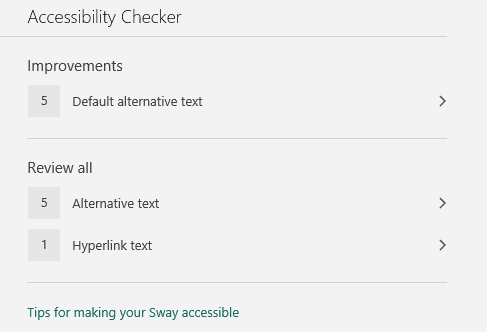
Quick import:
As well as being able to write content natively, it’s also possible to import a pre-existing document into Sway. This can be a something like a Word file or a topic outline from Wikipedia.
From there, Sway breaks the document down into its main components. A headline, titles, body text, images and tables for example. And displays it in your sway.
Sway can then takes this a step further, adding in a few extra touches. These additions are only cosmetic such as text extracts. But they vastly improve the visuals of the document.
Once you import the document, it can still be edited to get it to your liking. But from experimentations, Sway tends to do an already good job of presenting imported content.
Accessible anywhere and shareable with anyone:
Sway stores created sways in the cloud. Meaning that you can view any sway you want as long as you’re connected to the Internet and have access permission. This does have the downside of meaning that whilst offline, you won’t be able to access any sways. But for the increased flexibility offered by a cloud approach, it’s a worthwhile trade-off.
Being stored online also has the advantage of simplified sharing. The types of documents you make in Sway are meant to be shared. Whether that’s with only a few as with a report or many people as with a newsletter.
Having no need to upload or download any files and fiddle with versions is great. Considering that sways are often packed with rich media or images. You also get to avoid long transfer times due to a large file size because your sways are stored centrally.
Rich content:
Sway allows users to insert content from a variety of sources to enrich their presentation. Flickr, Bing Images and Pickit all offer a variety of images under the Creative Commons licence. Letting you use them freely as backgrounds or features within the sway.
Additionally, you can embed YouTube videos, tweets and Facebook posts into sways. Allowing for easy viewing and no need to link out of the presentation for content which is on another platform.
Of course, you can also embed any images or videos you already have into the sway. Either via OneDrive or by inserting the file into your presentation.
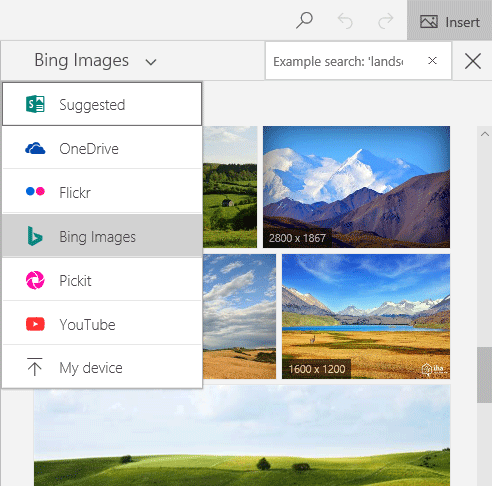
Slick presentation:
A major issue with PowerPoint presentations is that they can seem unprofessional or lack finesse. Which in turn reflects poorly on your business. Likewise, Word documents are difficult to organise and are often visually sparse. Sway on the other hand is built with elegant design and impressive visual performance in mind.
Through using the pre-made templates and styles – or creating your own – it’s simple to create a presentation which looks good and impresses your client or manager.
How to get Sway for your business
If you’re interested in getting Sway, it’s included for free within certain Office 365 licenses. If your business is yet to adopt Office 365, discover some of the great features you’re missing out on.
Other articles in this series:
For far too long Microsoft Azure has been sold as something it’s not – an instant magic wand for all your IT requirements.
Simply put, Azure is a tool for delivering an IT project and, as with any project, it’s important to choose the right tool for the job. The magic wand status of Azure has come from the fact that there are few IT infrastructure migrations where Microsoft Azure is not that tool.
The reason Microsoft Azure is used so often is (continuing the tool analogy) many cloud platforms are the equivalent of a hammer – very good at one thing, but perhaps less useful in other scenarios. Azure, on the other hand, is a Swiss army knife – highly capable and highly versatile in a range of situations.
With Azure, you can undertake projects ranging in size from running your entire IT environment in the cloud all the way down to a cloud-enabled file backup. Whatever you’re looking at doing, there are 8 key areas that can enhance an Azure migration project and save you unnecessary pains and costs in your journey. Here’s what they are:
8 considerations for a successful Azure migration
1. Ensure you have the bandwidth
In any migration, be it to a public or private cloud, bandwidth can easily be overlooked. It’s a factor that needs to be under continual evaluation – since missing something here easily swallows up savings.
It’s also important to be considering latency. Far too often, businesses move a service into the cloud which originally ran on a local LAN and realise too late their WAN can no longer support the additional load. The best-case scenario for if this happens is the newly migrated application runs slowly. The worst case is the entire network grinds to a halt.
2. Know your rollback
Even with all the experience in the world, unforeseen issues can arise during a project. Something goes wrong or is delayed and suddenly you needed that service yesterday.
Rollbacks are sometimes necessary to keep operations running smoothly, so knowing how you’re going to get back to your previous position is vital.
You should never be in a situation where there is no way back, nor should you attempt a ‘big bang’ migration. The risk you expose yourself to is simply not necessary.
3. Model your environment and true costs
On the surface, public cloud services (such as Azure) look cheap. However, when you start moving noisy programs and bandwidth-heavy systems, a different picture of how much you’re spending emerges.
Modelling your true costs prior to the migration is imperative to prevent your project from going grossly over budget. Don’t assume you will simply be paying for space and compute like you typically do with a cloud provider. It’s likely that reads and writes of data, as well as the costs of transporting it around, will be included as well.
This can quickly lead to you chasing bottle-necks, often in areas such as disk storage speeds and IOPS and therefore losing out on performance. A good place to start when sizing up your project is the Azure Migrate tool. The Microsoft Assessment and Planning tool is also valuable at this stage.
4. Ensure compatibility
One of the well-known phrases trotted out by service providers and software vendors when discussing if their application will continue to function if you move it to the cloud is: “well, it should work.” Many software vendors are still only in the exploratory stages of rigorously testing how their applications run in a public cloud environment, so take that “should” with a large grain of salt.
You should always be getting guarantees on performance and support prior to signing any migration and service contract. Too many service providers will simply sell a solution without proven experience. If in doubt build a test platform and test it to destruction.
5. Manage and Monitor
Whatever you’re hosting, you need to have the right monitoring, management and reporting in place to ensure there are no surprises during your journey to, and the time following your migration.
Before you enter the cloud, you need to know what service levels you require and what your capacity management structure is. You also need to consider where all your alerts and logs will go and how you’ll manage them and act when required.
Fortunately, there are numerous products to deal with these issues. Just be sure you start with the end in mind, instead of dealing with issues as you encounter them.
6. Consider DR and Continuity
Yes, Microsoft has a huge cloud infrastructure and yes, your data is replicated all around the place. But this doesn’t mean you won’t have an outage.
There are so many variables involved in cloud infrastructure that, chances are, you will at some point experience an outage. If you’re moving into Azure then know what your DR and business continuity plans and solutions are. Then once you know them, test them to ensure they’ll actually work when they’re needed.
7. Ensure you have the skills in place
Azure is a completely different ball game to managing a traditional private cloud platform or on-premise solution. It’s therefore important you either partner with a trusted consultancy and service provider and/or you skill up your internal team with training.
There’s a wealth of training solutions out there, and Microsoft’s own certifications are an excellent place to begin. Covering a wide and granular range of areas, allowing you to tailor your skill-set to exactly the right level.
8. Secure your environment
You can’t talk about anything related to IT without mentioning security, so this point was inevitable. The summary is that you shouldn’t treat your cloud platform any differently to your internal security. You certainly shouldn’t believe you can offload the risk to Microsoft.
Securing your cloud is a vast enough topic that it would be unjust to try and cover it under this one heading, but one key area often overlooked is watching the network – both for internal and external traffic. At a minimum, you should really be using Deep Packet Inspection and UTM firewall appliances, of which there are numerous in the Azure marketplace.
In summary…
As with any platform migration, it’s all about planning. The more you plan and prepare the smoother your migration will be and the lesser your costs. If you’re looking for a highly experienced consulting firm to ensure your Azure migration is successful, get in contact with us and one of our senior Azure consultants will be able to help you with your move into the cloud.
What is Delve?
Delve is a file hub, collaboration space and enterprise social network built using the Microsoft Graph and included in Office 365.
When trying to boil down a complex piece of software into its core functions, sometimes words fail to convey enough information. So if that previous description didn’t mean anything to, here’s an analogy instead: Delve is like a cupboard which intelligently and automatically fills itself with things from other cupboards. You might have the people cupboard where you store your co-workers (not literally, just their details), your file cupboard where you store your documents and a sharing cupboard where your co-workers put files they want you to have access to.
Whenever you open the main cupboard, Delve fills it with documents it thinks will be useful to you based on a range of criteria. If what you want isn’t in there, you can filter the contents of the cupboard to find it, otherwise, you can take out your file and get to work. Alternatively, you can look for people in the main cupboard and Delve will fill it with your co-worker’s details, a personal bio and other important information about what they’re doing and how to contact them.
Whilst the cupboard analogy may not be perfect, it hopefully gives you an idea of what Delve is for. If the cupboard analogy has failed you, then perhaps describing Delve as the online, cloud-enabled File Explorer v2 will fare better.
It’s important to note that a common concern with Delve is that it since all your files are accessible through Delve, all your files are surely stored on a Delve server. This is not the case. Going back to the cupboard analogy, when you open the main Delve cupboard all your files appear inside but are still in their respective cupboards. The Delve cupboard is simply a collation of the sources of your files and a collection of links to the sources. This means security or regulatory concerns over files being stored on an external Delve server can be dismissed.
What are the benefits of Delve for businesses?
Privacy as default:
Unlike social networks such as Facebook where the default is to expose all your pictures and posts to your social group, Delve keeps things private unless you specify you want the content to be shared. Granular control is given to users, allowing them to dictate who gets to see their files, keeping company information safe.
By default, a file on Delve has the same access permissions to where it’s stored. For instance, if you have a file stored on a private folder, only you will be able to see and access it through Delve. Alternatively, if you have a file stored in a shared OneDrive folder then only you and the people the folder is shared with will be able to see and access it.

A cloud application:
Delve is accessed through a web browser such as Chrome, Safari or Edge which means as long as you have an Internet connection, you can access the program. This is particularly valuable for remote workers as they gain just as much value from the software as an in-office employee does.
Boards:
Boards is a feature in Delve that works much like a tagging system. Clicking the little stack icon underneath a document allows you to add it to a board of your choosing. This system of using tags instead of folders gives Delve two distinct advantages:
- Firstly, it allows for a document to be in two places at once without having to create a copy of the file – improving navigation speeds, enabling more logical file storage and making it easier to access important files.
- Secondly, it prevents long folder chains which are often slow to navigate and can be awkward to use when trying to find a single specific file.

User profiles:
The enterprise social media platform aspect of Delve comes through most prominently in its user profile section. Profiles allow Delve users to include their contact details, a short bio, a list of projects being worked on, skills and expertise, schools and education and interests and hobbies which combine to give a good idea of the person whose profile you’re looking at.
Whilst the value of this feature for a large business is clear, in a small business where everyone knows each other it may not seem so useful. However, there are many cases where it comes in handy. The projects and skills and expertise sections in particular can be used to find out what everyone is currently working on as well as who would be the best person to ask for advice if you need help with your own projects.
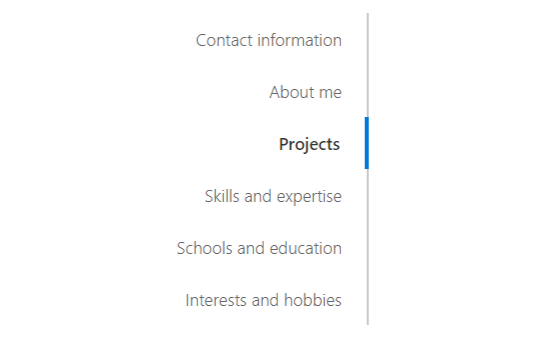
Built on the Microsoft Graph:
Microsoft Graph is a collation of activities and content collected from user actions across the Office suite. It allows for more personalised content to be displayed and syncs data across multiple Microsoft programs.
This means that using Delve alongside other Microsoft products provides further advantages and integrations. For example, Yammer conversations can appear in the list of content cards and can be pinned to your own boards and your recently accessed files appear more prominently on your documents page of Delve.
By integrating the data and user actions from across multiple programs Delve is able to provide a more personalised user-centric experience.
Intelligent search:
Rather than just looking at a document’s title, the search feature in Delve additionally scans the contents of a document for your search terms as well. This is particularly useful for when searching for a document someone else has made and shared with you, but you don’t know the title of.
Delve’s search function also lets you search by people, allowing you to look at their profile and see any documents they have shared with you alongside their details.
How to get Delve for your business
If you’re interested in getting Delve, it’s included freely within certain Office 365 licenses. If your business is yet to adopt Office 365, see our blog post on the topic to discover some of the great features you’re missing out on.
Other articles in this series:
What is Yammer?
Yammer is Microsoft’s take on a Facebook-esque social platform tailored for use in a business environment. Before you take this parallel too literally, it’s important to add that using the Facebook comparison brings some unwanted connotations and further clarification is needed to get a genuine picture of what Yammer can do for businesses.
Yammer, unlike Facebook, is a private social platform and the scope of the network is, rather than the whole world, just your organisation. The Facebook comparison works strongest when it comes to Yammer’s user interface and feature set, with many users likely finding familiarity in the layout and tools which are given to them: instant messaging, an update feed, @mentions, likes, groups, polls, hashtags, and announcements.
For the full picture, it’s also important to state that Yammer is one of the enterprise tools included within Office 365 and is a self-described “outer-loop” communication tool. Allowing users to engage with co-workers they rarely see or talk to from across the organisation.
Should I use Yammer or Teams?
With there being so many collaboration tools in Office 365, it’s easy to be overwhelmed by the range of options available. At an incredibly basic and simplified level, Yammer is for sending a message or announcement to large groups of people and Teams is for sending messages to individuals or smaller, more tightly knit groups.
Of course, this dichotomy only looks at using Yammer’s and Teams’ messaging functions and when comparing each program as a whole, it’s apparent that they both fulfil very distinct roles outside of their chat features.
For maximum business impact, you should be using both Yammer and Teams because each program offers various exclusive features the other doesn’t. However, to determine which program to use when sending a message the above breakdown is a good rule to follow.
What are the benefits of Yammer for businesses?
Builds better relationships
By enabling continuous communication, Yammer lets employees feel more connected and unified, even if they’re in different departments or office buildings. This helps them create stronger teams and makes working towards a common goal far simpler.
Additionally, through utilising group announcements and Yammer’s in-built praise feature, the latest achievements of staff members can be celebrated by everyone. Allowing a well-performing employee to be acknowledged for their hard work.
Effective knowledge sharing
Employees can gain meaningful answers to important questions by quickly and easily communicating with colleagues. Whether it’s asking for some details on a client, double-checking a meeting time or getting advice from more experienced staff, it can all be done through Yammer.
Improves employee engagement
By giving every employee the ability to be involved with company discussions, Yammer lets people feel more engaged with their company. More engaged employees are more productive, less likely to be distracted and are more likely to stay with the business. Making Yammer a powerful tool to have.
Yammer also has a multitude of options for engagement, including opinion polls, open questions and casual public chatrooms for a Friday afternoon.
Familiar layout
Many pieces of software are obtuse and require long periods of time to learn how to use effectively. Yammer on the other hand is instantly familiar to anyone who has used Facebook, Twitter or any type of online chatroom.
With a gentle and short learning curve, Yammer delivers immediate value to any business and sustains this value throughout its lifetime through the power of its many features.
Live communication
Yammer allows for departments and offices to communicate with one another in a far more effective way than traditional communication tools. Email and board-room meetings have their uses but often aren’t sufficient or suitable.
Yammer uses more social-media-esque features to provide an instant and streamlined discussion between groups or individuals. Allowing teams to stay connected and fostering continual discussion to keep employees engaged.
Versatile application:
Yammer is not only available for Windows, but also for Mac, Android and iPhone. Furthermore, Yammer can be accessed via any standard web browser, allowing employees to access the software without needing the dedicated application installed.
Being available over so many platforms and devices means that, regardless of your current hardware setup, Yammer provides value for your business. The addition of mobile applications also means just as much value is gained by remote workers or employees who are often travelling between sites.
Highly Integrated:
Yammer has integration capabilities with many other Office applications such as SharePoint and Skype for Business as well as external applications including Salesforce. It’s also possible to create custom integrations using the Yammer API.
In-built analytics:
Yammer has its own in-built analytics platform, enabling users or admins to monitor certain metrics such as how many messages are being posted, how many messages are being read and how active group members are.
This data can be used to check if everyone in the company saw an announcement or find out which groups are most popular with members for example.
How to get Yammer for your business
If you’re interested in getting Yammer, it’s included freely within certain Office 365 licenses. If your business is yet to adopt Office 365, see our blog post to discover some of the great features you’re missing out on.
